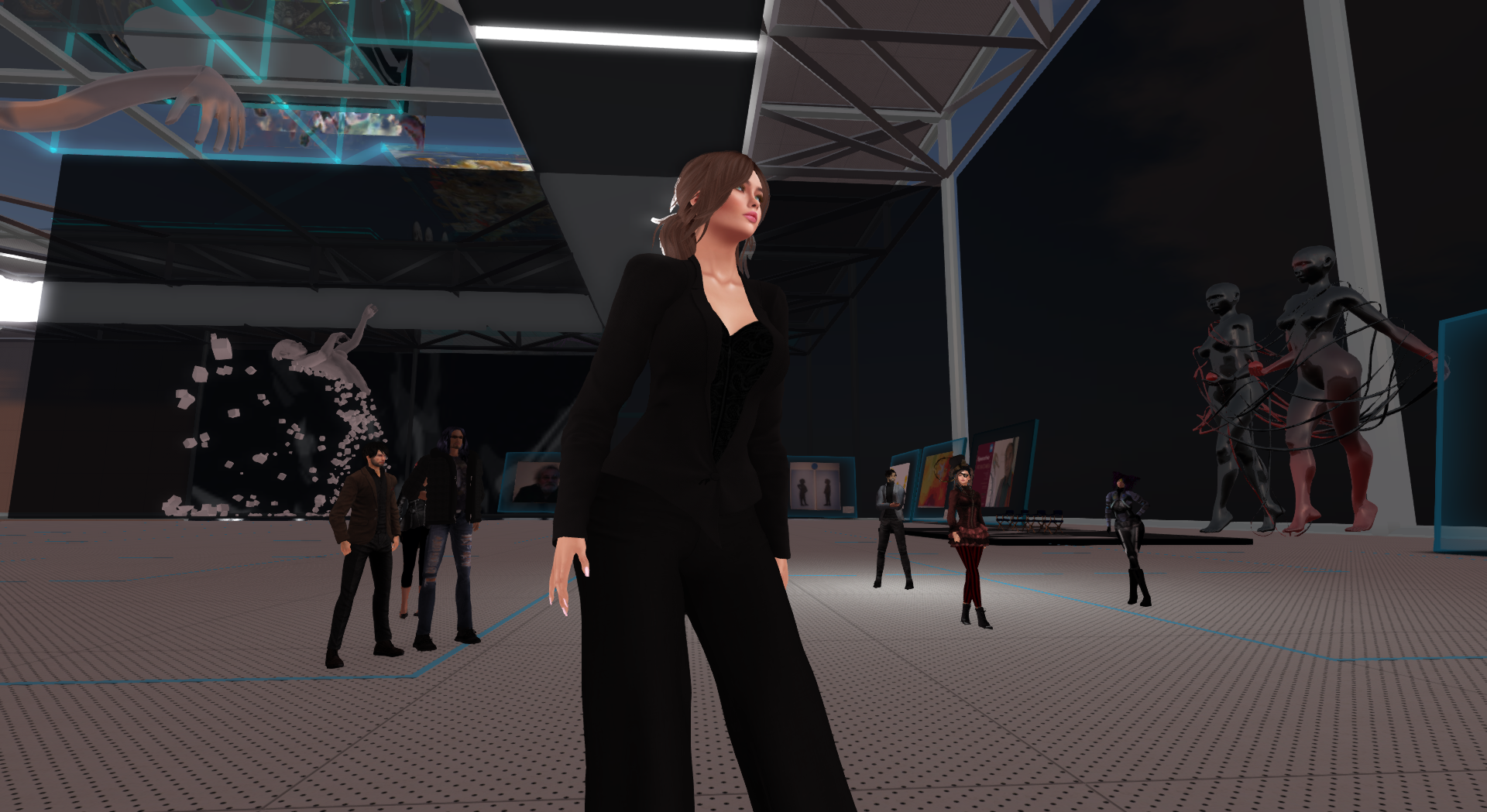Elisa Laraia aka Helissa Halasy, with American students attending the Master’s course in which she teaches Public Art and New Media, recently linked up from Bennington College in Vermont (USA) with Craft World, for a study tour of Rosanna Galvani’s Metaverse Museum and The City of Women, an educational project curated by Lorenza Colicigno, owner of Noilab, builder Tonino Lane
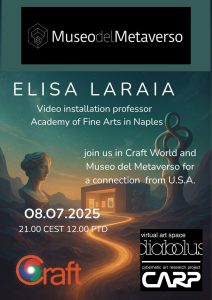
Elisa Laraia, visual artist and lecturer at the Academy of Fine Arts in Naples, creator and curator of the LAP Laboratory of Public Art, held an immersive lesson dedicated to the Metaverso Museum. In particular, the works of Daco Monday, Nicola Reinerman and Siberia IlfreddoPurifica were studied, which aroused the students’ interest in the suggestions and questions generated by the immersive installations, whose concepts were illustrated by Rosanna Galvani, the creator and curator of the MdM. Galvani briefly recalled the history of the Museum, starting from its birth in 2007 in Second Life. Since 2010, the Museum has moved permanently to Craft World, becoming the historical memory of art in the metaverse and offering digital exhibition opportunities to numerous artists, who are also active in real life. Also important in the MoM during this period were the experiments with AI by numerous artists, including Eva Kraai, Serghej Zarf, Fiona Saiman and Bruno Cerboni.
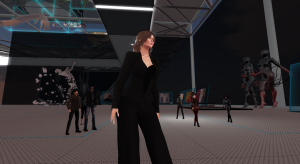
Elisa Laraia aka Helissa Halasy visiting the MdM
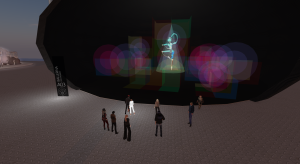
The Daco Monday Dancer Photo by Tonino Lane
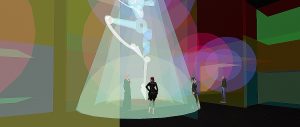
Effect of immersivity: the viewer enters the work of art Photo by Eva Kraai
‘In the heart of a metaphysical space,’ said, among others, Rosanna Galvani, “Daco Monday’s Dancer dances motionless, enclosed in a geometry of light and dream. Her body, reduced to an essential mannequin, faceless but full of presence, stands at the centre of a visionary composition, where matter dissolves in colour. Daco Monday thus takes us beyond the physicality of the body and beyond dance itself, towards an idea of transformation: the dancer is not just a subject, but an energy centre, a soul fluctuating between form and spirit. In this work, transparency becomes metaphor: everything is visible and at the same time mysterious, like the gesture that precedes flight.”
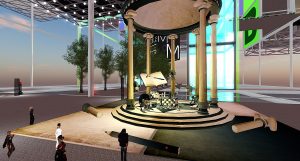
Untitled – a metaphysical journey between evolution and illusion by Daco Monday Photo by Eva Kraai
Galvani highlighted the three levels of Daco Monday’s work ‘Untitled’: “At the base, a small temple-pedestal stands out as a sacred and at the same time playful element: it is the origin, the principle, the first cell in the game of existence. Similar to a silent relic on a cosmic chessboard, the small temple appears as both object and subject: a totem that observes and participates. The second level is the plane of the chess game, inhabited by characters embodying the stages of evolution. Hybridised figures, archetypal, mechanical and organic at the same time, move on boxes suspended in the void. Each move is irreversible, each figure is both player and pawn. The game becomes a metaphor for existence and transformation: movement as destiny. Finally, soaring and unreachable, stands the tower-castle village, at once refuge, enigma and goal. It is not just architecture: it is a vertical dream, an inner city made up of closed spaces and illusory openings, of windows overlooking not the world but the imagination. Here time climbs, and thought refracts infinitely, as in an Eskerian spiral.”
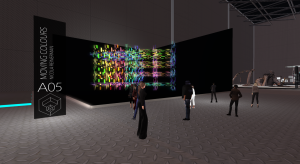
‘Moving Colours’ by Nicola Reinerman Photo by Tonino Lane
‘With Moving Colours,’ Galvani commented, “Nicola Reinerman immerses us in a hypnotic universe where colour comes to life, moves, breathes. The work, composed of a geometric figure made entirely of small moving colour squares, transforms space into a continuous visual flow, in which matter disappears and only energy remains.”
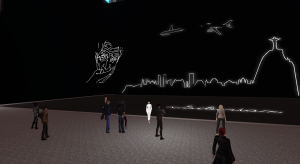
‘Landscape in motion’ by Siberia IlfreddoPurifica Photo by Tonino Lane
A continuous journey through the cities of the world, a tribute to Cavandoli’s Line and a tribute to transformation. ‘This continuous transformation,’ said Galvani, “is not only aesthetic: it is a poetic statement on time and identity. Cities become symbols of the flowing, incessant change that characterises contemporary life. Nothing stands still, everything transforms – but the line, as a guiding thread, remains. It is the real protagonist: a living trace, subtle and resistant, which connects the West and the East, the real and the imaginary, the individual and the collective”.
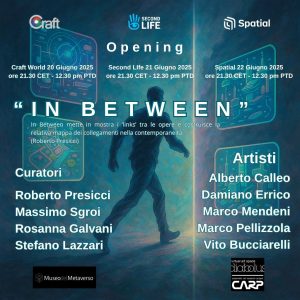
This was followed by a visit to the “In Between” exhibition, the latest to be opened by the museum, which explores the boundary between the real and digital dimensions. The exhibition was illustrated live by co-curator Roberto Presicci, who showed the students the work “The Abyss” by Damiano Errico.
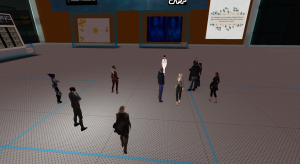
The exhibition ‘In Between’ Photo by Tonino Lane
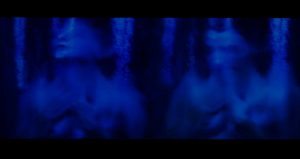
Frame from the video ‘The Abyss’ by Damiano Errico
The presence of numerous avatars inside the exhibition space, including artists whose works are permanently exhibited in the same museum, such as Daco Monday, Eva Kraai and Sergej Zarf, allowed for an exchange of views on the dynamics of art in immersive contexts such as Craft World, with respect to production-fruition in real life, and of the opportunities that virtual art also offers in relation to the knowledge of territorial museums that can be visited in digital form.
It was a not-to-be-missed opportunity,‘ said Galvani, hoping that the students were able to draw useful insights into digital art, ’to reflect on the role of the virtual museum, on the new museography in immersive environments, and on the educational and creative value that these spaces can offer students, artists and art lovers.
Elisa Laraia, in turn, thanked Rosanna Galvani for the work she does both on the level of curating exhibitions of artists working both in real and virtual art, and on the level of preserving the historical memory of digital art, pointing out that the next lesson would be devoted to a careful evaluation of the immersive experience from an educational point of view.
Afterwards, Elisa Laraia and her students visited The City of Women in Noilab. The educational value of the project was particularly highlighted. Starting with a visit to the castle of Isabella Morra, located in reality in Valsinni (Matera, Basilicata) and in Craft faithfully reproduced by the builder Tonino Lane on original plans, the project was retraced, housing around 100 female artists and writers of all times, intending to compensate them for the forgetfulness or lack of attention they have received over the centuries, in line with the UN Sustainable Development Goals 2030, no. 5 Gender Equality. An itinerary that starts from Eneduanna (2400 B.C.) to Virginia Woolf and contemporary female writers, hosted in the 10 buildings symbolising the evolution of culture over time, from the Sumerian house to the self-propelled houses of the year 2000, created, again by Tonino Lane, on the suggestions of Japanese architect Terunobu Fujimori, re-proposed for Craft by Italian architect Fabio Fornasari.
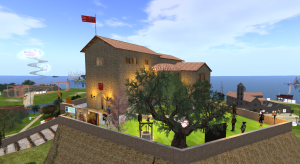
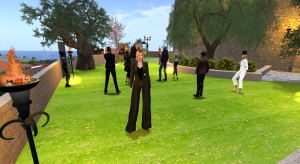
Visit to the Castle of Isabella Morra, Lucanian poet and victim of feminicide (1520 – 1546)
From the castle, set in an elevated position, the students’ gaze was able to sweep over the buildings that make up the urban-architectural structure of the City of Women project, stopping their attention on the Endless House and the Self-propelled Houses, expressions of innovative trends in 20th century and 2000 architecture.
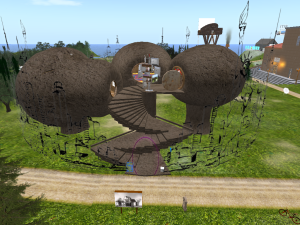
Endless House reconstructed in Craft for the City of Women project by Tonino Lane on the basis of architect Frederick Kiesler’s drawings, preserved at Moma (New York)
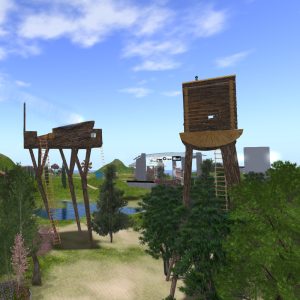
The self-propelled houses symbolising the year 2000 – Builder Tonino Lane, based on a design by Fabio Fornasari.
Elisa Laraia sent a message acknowledging the didactic and artistic value of the visit-study, emphasising the interest of American students in this virtual world in which art finds confirmation of traditional languages and offers space for new and unexpected experimentation.

